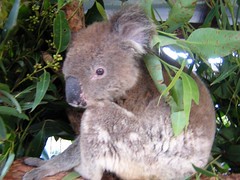Amanda tells me it's important to look for any abnormal whiteness in the faeces, which could be pus or mucus. I think I see some suspect poo in Cathie Sampson's yard and go over all Sherlock Holmes.Amanda wants to train me up as a back-up team-leader for the times that she, and potentially other team-leaders, can't make it for some reason. Today is the first day that I learn the ropes, and this will also mean being brave and volunteering to do the necessary handling. Being comfortable with handling is also necessary if I want to help in rescues some time in the future.
As a team-leader, Amanda starts at 7am as she has a range of duties to get through before the volunteers arrive at 8am. The leaf-collector has already been and gone by this time, taking the truck to collect the day's supply of fresh leaf. The first thing a team-leader does is check that the koalas in ICU are all okay. These are the sickest koalas in the hospital so there is always a possibility that one might take a turn for the worse during the night. If a koala is lying on the floor of their unit (as opposed to just prowling around on the floor, which they often do), it should be made warm by nestling it into a basket with towels like they do on rescues. There are also hot-water bottles in the treatment room, if necessary.
Assuming the ICU koalas are all okay, the next job is to read the leaf and poo for all the koalas not on the university research testing program (the uni researchers read their leaf and poo every morning). Amanda draws up a matrix showing the names of the all the koalas down one side and a list of leaf varieties across the top. The leaf-collector scribbles little codes in the day-book to indicate which leaf they have brought in that day: "SM" for swamp mahogany, "N" for nicholii, plus a host of other acronyms we're not sure of. This is a job of differentiation rather than identification; once we work out one leaf, we can generally tell the others by a process of elimination. Most of the non-uni koalas get recycle pots too, so the names of yesterday's leaf is also jotted along the top. This also helps with differentiating the leaf codes. Saussure would have a field day with this, I'm sure.
We start with Oxley Westi in yard 1 and then proceed through yards 2, 3, 4, 5, 6 and 9. We check that the poo looks okay: Amanda tells me it's important to look for any abnormal whiteness in the faeces, which could be pus or mucus. I think I see some suspect poo in Cathie Sampson's yard and go over all Sherlock Holmes. Amanda tells me that my sample is simply very fresh poo, which sports a glistening whiteness before it starts to dry out. Apparently, you just get to know mucusy poo when you see it. Ah, the arcane wisdom of the koalawrangling team-leader!
Most of the koalas have made a meal (geddit?) of swamp mahogany as usual; these branches are crowned in leafless spikes. Amanda puts little up arrows in the column when the koala has eaten a lot of that particular variety. They also get a tick if they produce a lot of poo; but it's more complicated than this. I'll have to get the hang of the symbols and their meanings before I would feel confident in my poo- and leaf-reading abilities.
As we wander around, Amanda opens the various doors and gates -- the laundry, yard 10. We head up to yard 10 to read Golfer's and Therese's leaf and then head back to the day-room to prepare the day's formula. There are two types of formula and two possible dosage amounts; some get an additional nutritional gel, while others get no food at all. Still others get drugs administered by the uni researchers and hospital supervisors, so those koalas' food goes into the treatment room so that the vollies don't go off and feed the koalas by accident. The feeding schedule is written up on the whiteboards that advise amount and type of formula and whether vollies can administer or whether the koala is undergoing a medication schedule. I'm pleased to see that Anna Bay Miles is still with us, given his debilitated and quite smelly state when I helped Cheyne feed her the other day. Hopefully that means he's responding to hospital care.
I've only ever washed up the feeding pots, not prepared them; and there's even a procedure attached to that. The pots and syringes soak overnight in an antibacterial solution, so they need to be rinsed clean of that. Amanda also uses a bit of paraffin wax to lubricate the syringes. Amanda separates the pots for each type of formula and dosage. We prepare the four yard 9 girls' food and set them aside in a tray. Three pots go into the treatment room for the vet staff. It's coming up to 8am, so it's time for me to doff my trainee team-leader hat and resume my vollie hat (and smock!) for a morning of koalawrangling.

No comments:
Post a Comment